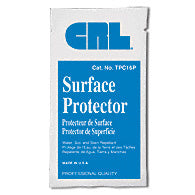- Transparent Polymer Coating
- Water, Soil, and Stain Repellant
- Protects Glass and Many Other Surfaces
CRL TPC Surface Protector will actually seal the pores of glass, porcelain, ceramic, plastics, polished metals, fiberglass, and marble to make the surface water, soil, and stain resistant. The clear coating guards against the adhesion and build-up of dirt, grime, mold, mildew, rust and mineral deposits. Environmentally friendly and non-toxic, CRL TPC Surface Protector permits the practice of preventive maintenance, reducing costly cleaning, repairs and replacement. Simply spray on and polish off. 1 Fl. oz. (29 ml) of TPC Surface Protector protects approximately 15 sq. ft. (1.4 meters square) of glass. Also available in 55 gl. (208 l) drums on special order.
Product Warning:
Check label and Material Safety Data Sheet for any additional limitations and warnings.
PROCEDURE FOR THE EFFECTIVE TREATMENT OF SAND-BLASTED GLASS
1. Due to the variable nature of the sandblasting process (i.e. different grit size and blasting pressure resulting in variable depth, etching configuration and amount of residual glass particles), before treatment with CRL TPC SURFACE PROTECTOR, sandblasted glass must be thoroughly washed and dried.
2. The CRL SURFACE PROTECTOR must be applied using a strong, padded cloth and a firm, circular and overlapping motion. The product should be allowed to dry (haze) and then it should be reapplied to ensure complete coverage.
3. When the surface is dry (i.e., the final "haze" has formed), the surface should be sprayed with plain water to test for uniform water beading. When the applicator is satisfied that the "beading" is uniform, the surface should then be washed with a mild detergent solution or an alcohol and water solution to remove all excess polymer (this "excess" is what sometimes looks like "stains" and makes the surface look darker in spots). Finally, the surface should be dried. THIS PROCESS WILL YIELD A PERFECTLY UNIFORM, WELL-TREATED SURFACE THAT WILL TYPICALLY LAST FOR YEARS UNDER ORDINARY USE.
While this appears to be a complicated procedure, it really is not. Most people who treat sandblasted glass in this manner ultimately agree that it is really quite simple once you get used to the process.
Product images shown are of the actual product or a close representation. Colors can vary depending on your computer's video card and on how your monitor's color is adjusted.

